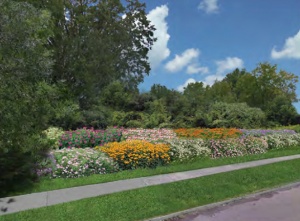 Just a few miles north from University of Michigan-Dearborn’s campus, on the site of former vacant homes in Detroit’ Cody Rouge neighborhood, four new innovative gardens have arrived. A type of green infrastructure, these pilot "bioretention gardens" are designed to help manage stormwater while removing neighborhood blight.
Just a few miles north from University of Michigan-Dearborn’s campus, on the site of former vacant homes in Detroit’ Cody Rouge neighborhood, four new innovative gardens have arrived. A type of green infrastructure, these pilot "bioretention gardens" are designed to help manage stormwater while removing neighborhood blight.
UM-Dearborn’s Assistant Professor Natalie Sampson is part of the team doing this work—a collaboration of academic, community, and government partners. Sampson brings her public health lens to the interdisciplinary team of scholars examining the benefits and limits of these gardens. With her colleague Noah Webster at U-M Ann Arbor’s Institute of Social Research, Sampson led a recent household survey to better understand the perceptions and preferences of residents living near the gardens.
This project contributes to efforts to use green infrastructure to manage stormwater and reduce combined sewer overflows throughout Detroit. The city’s sewer system is operating beyond its capacity and needs repair, having some lines dating back to the 19th century. With more than 3,500 miles of lines, the project is too big and costly—an estimated $1 billion—to fix at once. By design, the just-completed gardens in Cody Rouge are expected to achieve an average annual stormwater volume reduction of 300,000 gallons per site, for a total of 1.2 million gallons, and should help reduce street flooding during big storms.
"Projects like these are going to be extremely important as we move forward in the city. They allow us to make use of vacant land and to make it more productive, while at the same time eradicating blight in the neighborhoods," said Palencia Mobley, deputy director/chief engineer at the Detroit Water and Sewerage Department.
Landscape architect professor in U-M Ann Arbor’s School of Natural Resources and Environment Joan Nassauer led the pilot project, which was funded by $285,000 from the U-M Water Center with support from the Erb Family Foundation. An additional $500,000 investment was made by the Detroit Water and Sewerage Department (DWSD) to construct the gardens and instrumentation for them to gather data.
And in a recent grant to the U-M Water Center, the Erb Family Foundation awarded the research team $1.15 million to expand the scope of their work in collaboration with the City of Detroit, neighborhood organization partners, and non-government organizations that work to support Detroit’s green infrastructure activities.
Nassauer's lab designed the bioretention gardens, which were built on properties owned by the Detroit Land Bank Authority and managed by the DWSD. DWSD's green infrastructure program consultant, Tetra Tech, led the technical design and implementation of the gardens.
Nassauer said the social science surveys are essential in measuring the effect of the gardens on the neighborhood.
“We anticipate that having the gardens in their neighborhoods may help the overall neighborhood look more well-cared-for, enhance the property values of homes nearby, and increase residents' sense of safety,” Nassauer said. “Having the gardens may also encourage people to get outdoors to walk more and get to know their neighbors better. These are some of the things we are measuring in our surveys.”
Sampson and Webster are already beginning plans for the next round of surveys. Sampson knows that this is only the first phase, but she’s glad to see the gardens—once only a concept in their multi-year project.
“I drove by one of the gardens on Evergreen Road recently. I had to pull over to look at it. After two years of planning, the gardens are in. It’s exciting,” Sampson said. “But there is still a lot to be done to understand the potential impacts of these gardens for residents, for the environment, and for the city. And we need to keep gathering and sharing information to do that, and do it well.”
More information about the gardens can be found on the U-M Water Center website.



